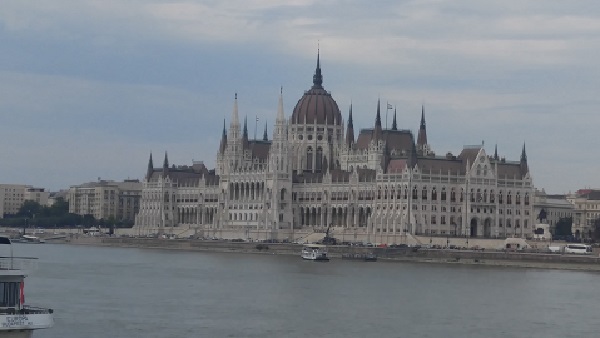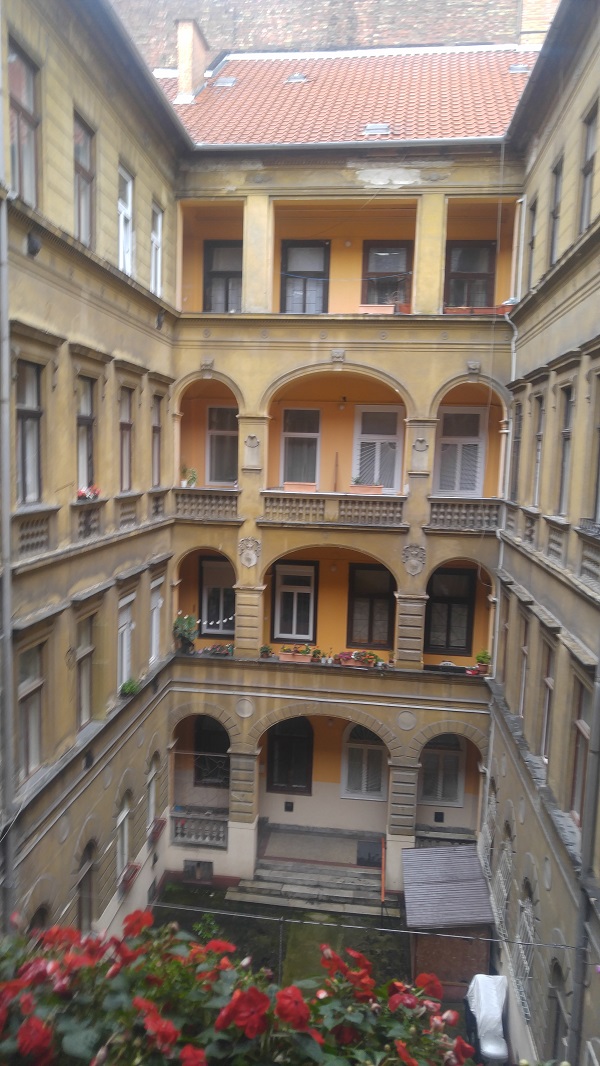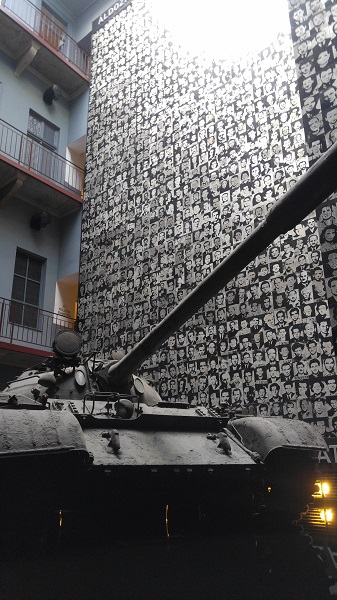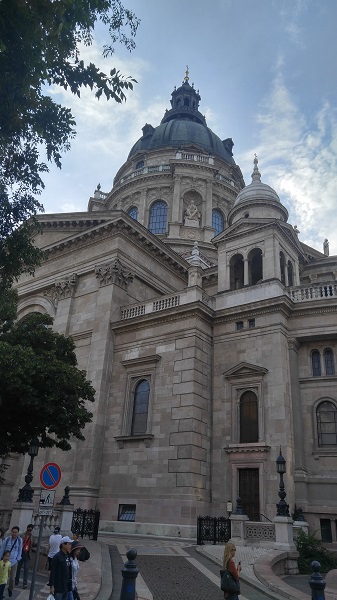Eastern Europe Travel Review and Pics
Forums:
Recently got back from Hungary>Slovakia>Poland, but between Phish and digging out at work, haven't had time to post some travel pics until now.
Trip started out in Budapest, which is one of my new favorite cities. Situated on the banks of the Danube, the hilly town of Buda on the west side of the river and the flat more developed town of Pest on the east side was the former boundary of the Roman Empire. The towns combined in the 1800s and now its a funky, friendly, and clean modern city:

One of the cool things about Eastern Europe is how, once you get over there, its so affordable. We stayed at AirBnbs most of the time we were over there. Here is the courtyard of the place we stayed in Budapest right in the heart of the historic cool part. Two bedroom apartment for $50 per night. There was a grocery store right down the street and everything was about half US store prices, with the exception of certain specialty items. The restaurants and bars around there were very affordable too and just walking around and checking out everything is worth the price of admission.

The town has more museums, castles, and historic stuff than you can shake a stick at. We checked out "Castle Hill," in Buda and went into the Labyrinth - a series of caverns below the city with absolute darkness parts, thick fog, and crazy lights. Supposedly, Vlad Dracula was imprisoned there for a stint and you wouldn't want to go down there if you ate the acid. Anyway, also checked out an extensive military museum (for being on the losing side in two World Wars, Hungary has it so surprisingly well preserved), soaked in a 1500s bathhouse, and visited the House of Terror which was the former headquarters of the Soviet era secret police. They still had the soundproofed torture rooms. Here is a Russian tank used to put down the 1956 uprising in front of a collage of pictures of people killed by the Communists:

The architecture of Budapest was the best part. It got through WWII with much of it intact and there were funky buildings at every turn. Here is the cathedral of St. Stephen. I heard they had the preserved hand of St. Stephen in there, but we didn't have time to go in as we had to get on a bus to Slovakia the next day. To be continued. . .

- Log in to post comments

Top of Page Bottom of Page PermalinkFull Name: Sycamore Slough
Cool Stuff !!
Cool Stuff !!
Top of Page Bottom of Page PermalinkFull Name: treat island
I'm enjoying your report and
I'm enjoying your report and your photos and looking forward to more installments. Thank you.
Top of Page Bottom of Page PermalinkFull Name: Bryen
http://vienna-pyongyang
http://vienna-pyongyang.blogspot.com/2008/04/how-everything-began.html?m=1
Top of Page Bottom of Page PermalinkFull Name: Druba
Most excellent Ken, thanks
Most excellent Ken, thanks for sharing!
Top of Page Bottom of Page PermalinkFull Name: Bryen
It is most excellent, I've
It is most excellent, I've heard nothing but good things about Portland Ken, if he's friends with Utah Jen then he's alright by me
https://youtu.be/o0ms_1vkl18
Top of Page Bottom of Page PermalinkFull Name: Bryen
https://youtu.be/gcKdtOhfno4
https://youtu.be/gcKdtOhfno4
Top of Page Bottom of Page PermalinkFull Name: utahmountaingirl
Wow! Great photos! I've been
Wow! Great photos! I've been wanting to do a trip like this. Looks like a great time!
Bryen! :)
Top of Page Bottom of Page PermalinkFull Name: Ken D.
Here are some more pics.
Here are some more pics.
After Budapest, my brother, son, and I took a bus to the capital of Slovakia, Bratislava, where we had a six hour layover for our train to the Carpathians. Its much smaller town than Budapest, but had a cool castle overlooking the town and an old, pedestrian only medieval quarter:
We then took a train out of the city to the town of Trencin in the foothills of the Carpathian Mountains. This was the first place we found a lot of people who didn't speak English. In Budapest and Bratislava, we found that almost everyone we ran into spoke English well and many of the signs were also in English. Its not as if the place is overrun by American and British tourists. Instead, English is used as a lingua franca and you would see people from different Eastern European countries using it to communicate with one another. However, up in Trencin, many people didn't speak a lick of English and we didn't speak a lick of Slovakian. But many of the people, especially the older ones, spoke Russian and my son had taken a couple of semesters of Russian in college. Between that and a lot of pointing and gesturing, we were able to get along fine.
The town of Trencin itself was pretty cool. Old cobble stone streets with a big castle overlooking the town (it was a pretty common theme):
From Trencin, we took a day trip to the ruins of Cachtice Castle - the former residence of the infamous Countess Elizabeth Bathory. As any fan of Gothic Horror knows, Countess Bathory (a real life cousin of Vlad Dracula) kidnaped, murdered, and bathed in the blood of up to 600 girls and young women in a macabre attempt to retain her youthful looks. At first, the Countess' victims were girls from the local villages lured to the castle with promises of work. However, once young ladies attending the Countess' elite etiquette school started to turn up missing, her crimes finally came to the attention of the authorities in Budapest, who arrested the Countess and sealed her alive in the walls of her castle. Anyway, the trip to Cachtice Castle was interesting. We took the train to the tiny village of Visnove at the base of the castle and getting dropped off in this sleepy village and being greeted by only wandering sheep helped set the mood for the visit. We then climbed up a steep, unpaved trail through the forest and didn't see another soul until we got to the ruins:
Top of Page Bottom of Page PermalinkFull Name: Lucky Day
Sweet. Thanks for sharing.
Sweet. Thanks for sharing.
Top of Page Bottom of Page PermalinkFull Name: Ken D.
After Trencin, we were a bit
After Trencin, we were a bit castled out, so we headed to the Tatras region, featuring the highest peaks in the Carpathian Mountain Range. We stayed in the town of Poprad at the base of the mountains. Our Airbnb was an apartment in an old school Soviet era tenement building, but decked out in country kitsch. Anyway, we took a train and two gondolas up to Lomnicky Stit, the second highest mountain in the Carpathians. There, we spent the day scrambling over boulder fields and saw a herd of chamois, a species of goat-antelope:
Top of Page Bottom of Page PermalinkFull Name: Lord Kalvert
thanks Ken - great trip
thanks Ken - great trip
Vigo de Carpathian
Top of Page Bottom of Page PermalinkFull Name: Ken D.
After our time in the
After our time in the mountains, we took a harrowing mini-van ride from Poprad to Krakow, Poland on a bus called the Leo Express. It got us their early, but the driver was crazy. Anyway, Krakow somehow survived WWII intact and the old town, with the largest medieval town square in Europe, was nicely preserved and bustling with street musicians and throngs of tourists from all over Europe:
On our first night in Krakow, we headed over to the Tauron Arena and saw Peal Jam. Great show which was documented in a separate thread a few weeks ago. Anyway, the arena had the most expensive beers we had seen on the whole trip - $2.50!
Another thing I realized while Eddie got a a sea of white arms waiving during the show was how white Poland and Slovakia were. In fact, the only black person (or any person of color) I saw since leaving Budapest was a guy on Pearl Jam's road crew. As opposed to countries like France and Germany, Eastern Europe has taken a hard line on immigration and many of the countries are run by right wing Trump like nationalist figures such as Poland's Duda and Viktor Orban in Hungary, who has taken great pride in fortifying the country's southern border against migrants from Africa and the Middle East.
Top of Page Bottom of Page PermalinkFull Name: Ken D.
The next day, we took a local
The next day, we took a local bus an hour outside Krakow to the Auschwitz-Brikenau death camps, where the Nazis murdered 800,000 people in gas chambers and another 200,000 died of starvation, disease, or exhaustion in the labor camps. Auschwitz is the older of the two camps and its where Dr. Josef Mengele conducted his unspeakable experiments in Building No. 10 and the SS developed their gas chamber/crematorium system:
After the Nazis perfected their murderous technology, they opened up Birkenhau a couple kilometers away. This camp was 10 times the size of Auschwitz and is where the vast majority of the killings happened.
The Nazis blew up most of the crematoriums as the Red Army was approaching in attempt to hide their crimes, but the ash pits holding the remains of their victims are still visible:
The way it worked was that train car loads of Jews, Roma, Polish dissidents, and other undesirables would pull into the gates. There, Nazi doctors would inspect everyone and divide them into two groups. Those deemed fit for work were marched off to the barracks in the work camps. All the others, were then segregated and taken to the showers, where they were immediately put to death. The ever practical Germans didn't let anything go to waste and all the belongings brought to the camps by the victims, from hair brushes to pots and pans, were gathered and organized. The mounds of human hair to be used as stuffing in floor mats was particularly chilling:
Top of Page Bottom of Page PermalinkFull Name: Ken D.
On a much more lighter note,
On a much more lighter note, the day after that we checked out the Wieliczka Salt Mine outside Krakow. Founded in the 11th Century, it is the oldest continuously operated mine in the world, but what makes it special is that over the centuries, the miners have carved out elaborate chambers, chapels, and statues from solid salt rock:
They even carved a salt statue of Krakow's hometown hero, Pope John Paul II:
Top of Page Bottom of Page PermalinkFull Name: Ken D.
Finished up the trip in
Finished up the trip in Warsaw, which was a bit different from everything else we saw. It was completely obliterated during WWII, so most of the architecture is a mix of drab Soviet era concrete buildings and post-Communist skyscrapers. They did have an extensive and well done museum on the 1944 Warsaw Uprising, when the Poles, after almost six years of Nazi occupation and anticipating the imminent liberation by the advancing Russian army, rose up against the Germans. Tragically, Stalin ordered the Red Army to halt just outside town, where they watched as the Poles and Germans fought it out. After four weeks, the uprising was crushed and the vengeful Germans systematically demolished everything still standing in the town.
Here is a "Goliath" remote control explosive tank the Germans used to help crush the uprising:
Despite the total destruction of the city, the Poles have since meticulously rebuilt the old town neighborhood where we were staying brick by brick, block by block and restored its original pre-war appearance:
Top of Page Bottom of Page PermalinkFull Name: Johnny D
Incredible trip and stories,
Incredible trip and stories, Ken! Lots of beauty and a serious dose of horrific reality.
Thanks for sharing!
Top of Page Bottom of Page PermalinkFull Name: ParadiseWaits
Love the travel tales and
Love the travel tales and photos, Ken! Thanks for the great read!